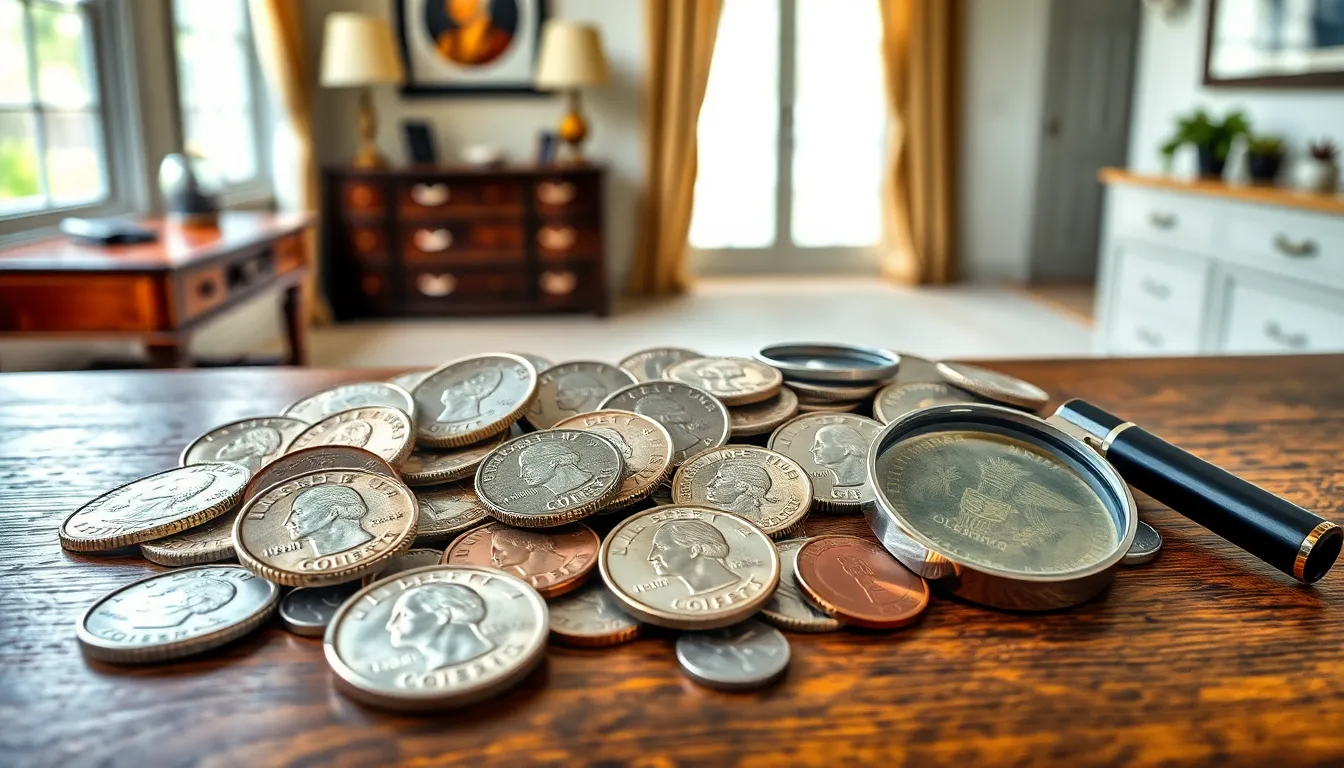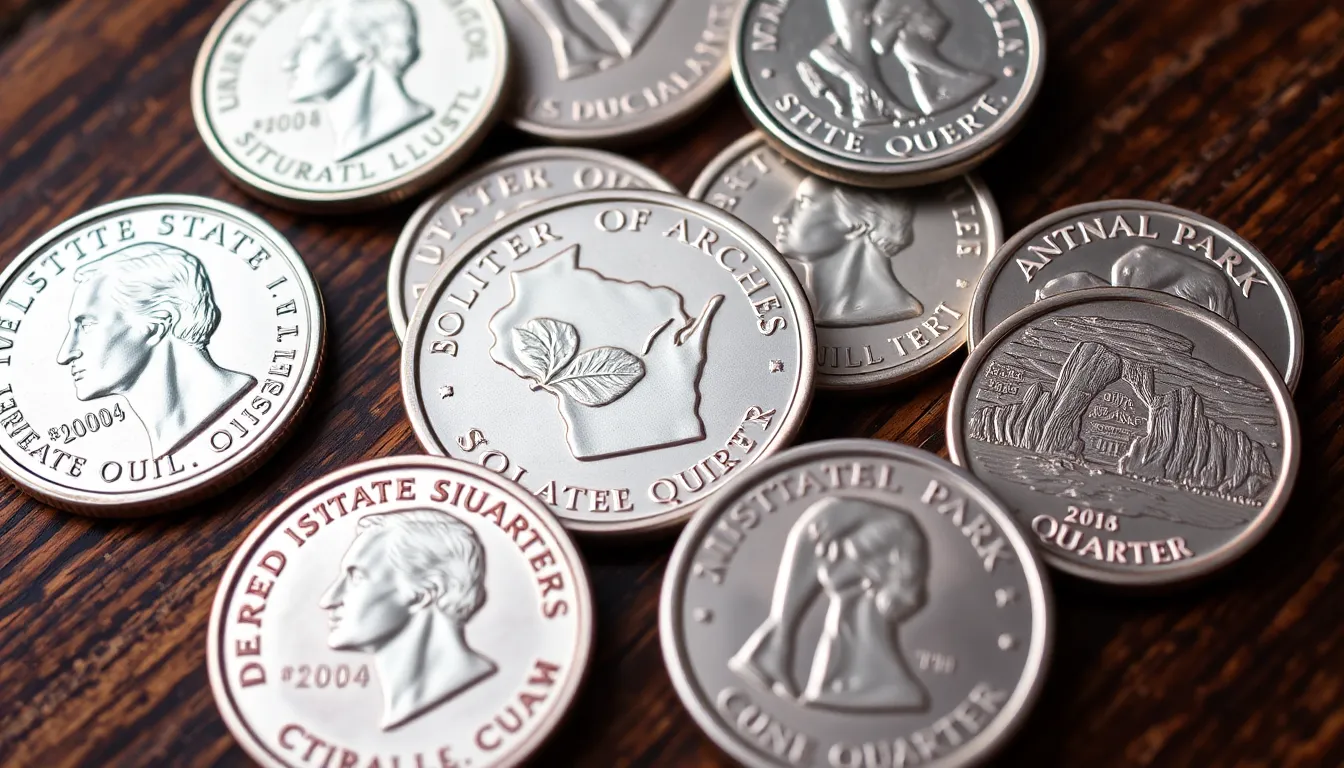Quarters might seem like just another coin jingling in your pocket, but some of them could be worth a small fortune! Imagine reaching into your couch cushions and pulling out a quarter that could buy you dinner instead of just a soda. It’s like finding hidden treasure in plain sight.
Table of Contents
ToggleTypes of Modern Quarters
Certain types of modern quarters hold substantial value beyond their face value. Understanding these specific categories can help collectors identify potential treasures.
State Quarters
State quarters feature unique designs representing each U.S. state. Minted from 1999 to 2008, these coins offer more than just collectible appeal; some have high market values. Certain states, like Minnesota, offer special errors where the “Vermillion” sign appears instead of “Voyageurs.” Collectors often pay premiums for such rarities, with some examples exceeding ten dollars. Variants such as the 2004 Wisconsin quarters, which feature the extra leaf error, can command prices over twenty dollars. Awareness of these specific editions is crucial for anyone assessing potential value.
National Park Quarters
National Park quarters highlight America’s natural beauty through their designs. Released starting in 2010, these quarters celebrate various national parks and sites. Some examples, like the 2014 Arches National Park quarter, show increased collector interest, especially if found in uncirculated condition. The best-known variant includes the 2013 Great Basin National Park quarter with the “D” mintmark, sought after for its limited availability. Coins like these can fetch values higher than five dollars, particularly if they retain their original luster. Identifying these high-demand quarters can significantly enhance a coin collection.
Factors That Affect Quarters’ Value

Understanding the factors that affect a quarter’s value is essential for collectors. Several key elements contribute to determining how much a specific coin may be worth.
Rarity and Demand
Rarity significantly influences a quarter’s market value. When few coins are available, demand increases, driving prices higher. State Quarters, especially those with unique errors, like the Minnesota quarter featuring the “Vermillion” error, illustrate this concept. Demand also plays a critical role; collectors often seek coins with historical significance or unique features. Popular National Park Quarters, such as the 2013 Great Basin National Park quarter, demonstrate how rarity and demand work together to enhance value.
Condition and Grading
Condition affects a quarter’s value by determining its grade. Coins in uncirculated condition inherently possess greater value than those that show signs of wear. Professional grading services evaluate coins based on criteria like luster, surface quality, and overall appearance. Well-preserved examples of State Quarters, like the 2004 Wisconsin quarter with the extra leaf error, command higher prices. Collectors actively seek coins graded at MS65 or above for the best potential returns. Understanding the grading system aids collectors in identifying valuable quarters in their collections.
Notable Modern Quarters to Look For
Certain modern quarters are more than just currency; they hold significant value for collectors. Here are a couple of notable examples.
2004-D Wisconsin State Quarter
The 2004-D Wisconsin State Quarter features an exciting error known as the “extra leaf.” Coins exhibiting this error can fetch prices ranging from $10 to over $20 in uncirculated condition. Collectors often seek this particular quarter due to its unique appeal. Its design includes the outline of a cow and corn, representing Wisconsin’s agricultural heritage. Minted in Denver, this quarter has become a must-have for many numismatic enthusiasts.
2019-W National Park Quarters
The 2019-W National Park Quarters introduced a limited mintage from the West Point Mint. Featuring designs that celebrate America’s natural wonders, these coins can command premium prices, particularly in uncirculated condition. The “San Antonio Missions” and “Frank Church River of No Return” editions are especially sought after, with values exceeding $20. Collectors consider these quarters valuable due to their unique mintmark and limited release. These quarters not only serve as currency but also as cherished items in any collection.
How to Evaluate Your Quarters
Evaluating quarters for value involves examining several key aspects. First, identify the year of minting and the type of quarter. State Quarters minted from 1999 to 2008 feature unique designs for each state, and certain rare editions can be significantly valuable. For example, the Minnesota quarter with the “Vermillion” error may fetch over ten dollars, while the 2004 Wisconsin quarter with the extra leaf error often commands more than twenty dollars.
Condition plays a crucial role in the assessment of a quarter’s value. Coins in uncirculated condition offer higher worth compared to those that show signs of wear. Seek to understand grading systems, as coins graded at MS65 or above attract collectors, fostering increased demand.
Consider the rarity of the specific quarter type, as limited availability drives prices higher. National Park Quarters released starting in 2010 highlight America’s natural beauty. The 2014 Arches National Park quarter and the sought-after 2013 Great Basin National Park quarter are especially collectible in pristine condition.
Professional grading services evaluate quarters based on luster and surface quality. Learn to recognize the significance of each detail, as unique features may enhance a quarter’s desirability among collectors. Keep in mind that the 2019-W National Park Quarters, particularly the “San Antonio Missions” and “Frank Church River of No Return” editions, are noteworthy for their limited mintage and potential high value.
Tracking market demand for certain quarters proves beneficial, as historical significance often elevates desirability. Collectors seek quarters with unique attributes, making awareness of specific coins that hold value essential for anyone evaluating their quarters.
Modern quarters can surprise collectors and casual finders alike with their hidden value. By recognizing the significance of rarity and demand one can uncover coins that are worth much more than their face value. Whether it’s a unique State Quarter error or a pristine National Park Quarter the potential for profit is real.
Understanding grading and condition is essential for determining a quarter’s worth. As collectors seek out specific editions the excitement of the hunt continues. With a little knowledge and attention to detail anyone can turn a simple coin into a valuable treasure.




